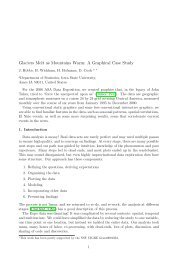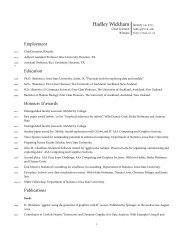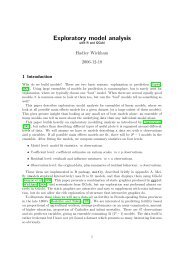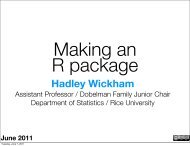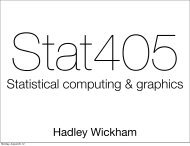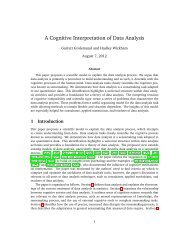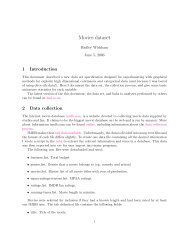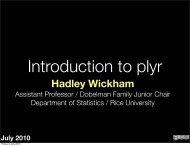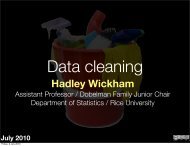Statistical inference for exploratory data analysis ... - Hadley Wickham
Statistical inference for exploratory data analysis ... - Hadley Wickham
Statistical inference for exploratory data analysis ... - Hadley Wickham
Create successful ePaper yourself
Turn your PDF publications into a flip-book with our unique Google optimized e-Paper software.
<strong>Statistical</strong> <strong>inference</strong> <strong>for</strong> graphics 4379<br />
(iii) HSBC (‘The Hongkong and Shanghai Banking Corporation’) daily stock<br />
returns (figure 5 ): For the short 2005 series, the reader should have had difficulty<br />
discerning the real <strong>data</strong>. This is a year of low and stable volatility. Because<br />
volatility changes are the major time dependencies in this type of <strong>data</strong>, the real<br />
and permuted stock returns are quite indistinguishable. The long series <strong>for</strong> the<br />
years 1998–2005, however, features quite drastic changes in volatility, such as two<br />
volatility bursts, one in 1998 due to the Russian bond default and the LTCM<br />
collapse, the other in 2001 due to the 9/11 event. Thereafter, volatility peters out<br />
and stabilizes at a low level.<br />
Solution: In both lineups the real <strong>data</strong> are shown in plot 3.<br />
(iv) Boston Housing Data (figure 6 ): The real residuals show pronounced<br />
structure compared to the null residuals. For most parts, the real residuals move<br />
more tightly than the simulated ones, except <strong>for</strong> two major excursions in the<br />
high 300s. We may surmise that the order of the census tracts in the <strong>data</strong> is<br />
spatially coherent in that tracts nearby in the <strong>data</strong> order tend to be nearby<br />
geographically. If correct, the deficiency established in this type of plot points to<br />
spatially coherent lurking variables that are not in the <strong>data</strong>.<br />
Solution: The real <strong>data</strong> are shown in plot 20.<br />
(v) Leukaemia <strong>data</strong> (figure 7 ): Most plots with permuted <strong>data</strong> show separable<br />
class structure. However, the plot of the real <strong>data</strong> shows the most separable<br />
class structure, which suggests that there appears to be stronger distinction<br />
between the classes than would occur by chance with so many variables and<br />
so few cases.<br />
Solution: Plot 1 shows real <strong>data</strong>.<br />
(vi) Wages <strong>data</strong> (figure 8 ): In the plot of the real <strong>data</strong>, the three curves differ<br />
in two ways: (A) the solid line flattens out at about six years of experience and<br />
never increases to be equal to the other two lines and (B) the three curves are<br />
all different in the later years, around 10 years. Now which of these features is<br />
present in the null <strong>data</strong> plots? Although a mid-experience flattening is present in<br />
several other plots (e.g. 18, 7), feature A is more extreme in the plot of the real<br />
<strong>data</strong> than in any of the other plots. Feature B is present in almost every other<br />
plot and is more pronounced in a plot of the simulated <strong>data</strong> (e.g. 16, 1, 20).<br />
Solution: Plot 9 shows real <strong>data</strong>.<br />
In this example, the artefact in the null <strong>data</strong> is more pronounced than the feature<br />
of interest in the real <strong>data</strong>. In fact, this pattern, where the smoothed line dips<br />
around 8 years of experience, is so pronounced we suspect that many readers will<br />
have selected this as the most different plot. A seasoned <strong>data</strong> analyst might not<br />
be fooled, though, because it is well known that there can be edge effects with<br />
smoothers particularly when there are fewer points in the extremes. Without the<br />
careful wording of the question to point out that we are looking <strong>for</strong> differences,<br />
some readers may have been tempted to select plot 8, where the curves are<br />
almost all identical. The presence of multiple features can be both beneficial<br />
Phil. Trans. R. Soc. A (2009)<br />
Downloaded from<br />
rsta.royalsocietypublishing.org on January 7, 2010




